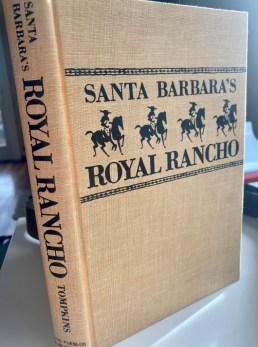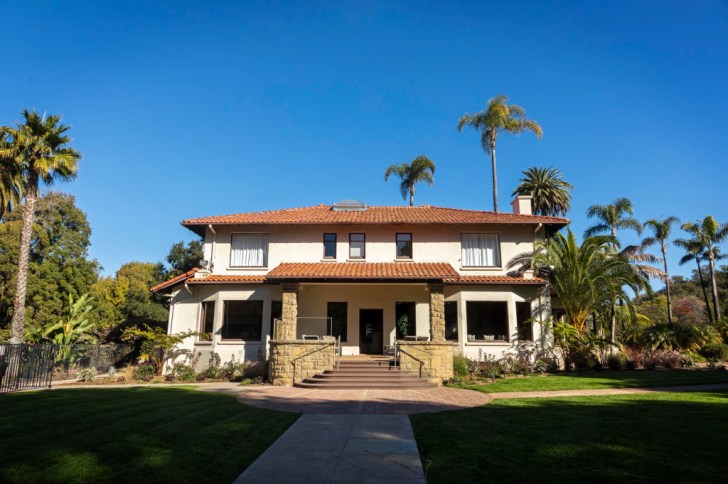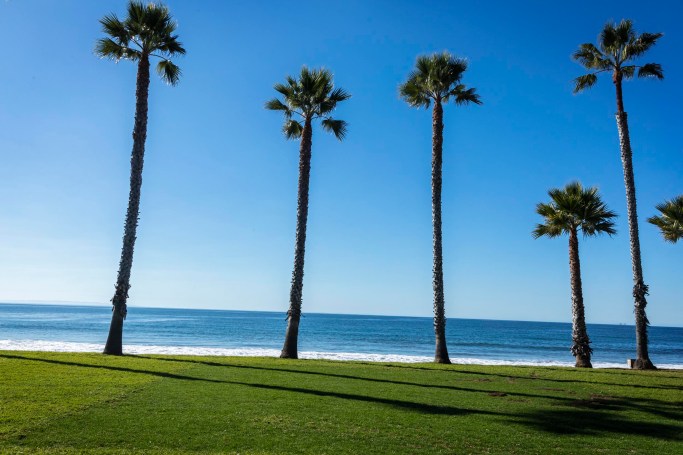Daring Dreams for
Dos Pueblos Ranch
Conservation, Education, Restoration, and More Planned for Historic Gaviota Coast Property
By Matt Kettmann | Photos by Macduff Everton | January 5, 2023

With an otter pelt slung from his shoulder and a kelp-bulb rattle shaking in his hand, Aleqwel Mendoza and his wife, Marissa Velez, are singing verses from their Chumash people’s pelican song, just as a lone pelican flashes alongside the nearby cliffs and dives into the sea. It’s a few days before the winter solstice, and the sun is burning warm and brilliant above the small group of us who’ve gathered at Dos Pueblos Ranch to talk about ways of the past, challenges of the present, and hopes for the future.
The couple had just finished an up-tempo song about the woodrat near where their ceremonial solstice pole — its yucca shaft covered in asphaltum and abalone shell, topped with blue heron feathers — will soon be hoisted to overlook the Santa Barbara Channel. A little while earlier, after chopping tule reeds from the estero to weave, Mendoza had let out a few lines from a whale song when we saw one spout a couple hundred yards off of the coast.
We’re standing on the grassy Gaviota Coast bluff that for generations housed the Chumash village of Mikiw, just across a creek from the neighboring clifftop village of Kuya’mu. Velez draws her ancestral ties to these villages — specifically to Chief Beato Temicucat, who died in 1821 — while Mendoza’s roots are a touch farther west, at the village of Qasil, in today’s Refugio Canyon. As “most likely descendants,” or MLDs, from this coastal paradise, both dream of a more established, rather than passing, presence around these ancient sites, one that synthesizes spiritual, educational, historical, and ecological goals into a cohesive experience.

Given the massive acreages and even more massive dollar signs associated with this coveted coastline, which is one of the last stretches of relatively pristine seaside Southern California, creating such a place here has always seemed far-fetched. But with Dos Pueblos Ranch under new ownership — and one that’s motivated by preservation over profits — the notion of meaningful and maintained Chumash involvement sounds much more possible.
Indeed, incorporating the Indigenous community is one of the initial ideals for the Dos Pueblos Institute, which now manages this land. The brand-new nonprofit was launched in January 2022 when the 214-acre ranch was purchased by Roger Himovitz. The progressive-minded developer and land conservationist is best known around these parts for creating the El Capitan Canyon resort, which sits two miles to the west. While turning that property’s once-rustic campground into a premier glamping operation, Himovitz helped dedicate the 2,500 surrounding acres to the state park system, and then played integral roles in preserving another 7,500 acres around Santa Barbara County through various deals. What happens at Dos Pueblos will be his lasting legacy.
The Chumash people — of which Mendoza and Velez represent a fraction of potential players — are just one of the stakeholders in what that legacy might look like. There’s nature to restore, historical structures to save, school groups to teach, and agriculture to revive in regenerative ways. In time, Himovitz wants the ranch to become a global center for ecological thought.

| Credit: Courtesy
While tackling that laundry list of future to-dos, the Dos Pueblos Institute is already facing the pressing bottom-line issues of now. Though wealthy, Himovitz is not a bottomless pit of money. So how can the ranch generate enough income to recoup the existing investments, fund future land purchases, and make the institute self-sustaining? What sort of operations will the community and county planners tolerate in exchange for helping these daring dreams come true?
The search for these answers remains in the formative stage. But no matter the outcome, it would be hard to find a more symbolic setting for such a grand experiment. The very name “Dos Pueblos” harkens back to October 17, 1542, when the explorer Juan Cabrillo anchored his ships off of the two villages. As the first contact between Europeans and the people of what would become Santa Barbara County, this visit triggered a cultural and ecological cataclysm that continues to reverberate today.
Over the centuries, Dos Pueblos Ranch bore witness to it all, from the Chumash, Spanish, Californios, and Yankees to the farmers, developers, surfers, skaters, pot-growers, politicians, and environmentalists who continue to plot what this landscape will look like. Will this be the place that untangles our modern mess? A land that resets our relationship to nature, repairs connections between cultures, and provides a model for how to do that everywhere else? Can Dos Pueblos salvage our broken world?
The Motivation
As much as he shies from attention, everyone who hopes or worries about the future of Dos Pueblos wants to know what makes Roger Himovitz tick. Only after much cajoling did he open up to me for this article, and we’ve known each other since 2003, when we participated in a wild fundraising bicycle trek from the Bolivian Andes to the Amazon with middle school students, including his own daughter.
“My belief is that people have become disconnected to our environment,” Himovitz explained to me over the phone on a conference call with attorney Rob Egenolf, his right-hand man in this project. “If we’re going to survive as a species, it’s going to be because we recognize how interdependent we are on the land. It’s important to me to continue to do these conservation-oriented projects to preserve the land from overdevelopment and to reconnect people to it. That’s what my vision for the Dos Pueblos Institute is, and that is really from where my motivation comes.”

Born in Los Angeles but raised in the San Joaquin Valley town of Hanford, Himovitz attended college in Alabama during the heady 1960s, marching — and getting arrested — with Martin Luther King Jr. in Selma on Bloody Sunday. Eventually graduating from UC Berkeley in 1968, he volunteered to serve for the Navy Seabees during the Vietnam War instead of attending law school, and returned to work in his family’s construction business. That led to real estate development, mostly in San Luis Obispo County. Though never thinking he’d become a family man, Himovitz married Robin Pattis almost 40 years ago, and they had four kids, raised primarily in Montecito.
His affinity for the Gaviota Coast concretized in 2000, when he purchased El Capitan Canyon and turned the simple campground popular with RV owners into a world-class glamping operation, with cozy cabins, daily activities, and an on-site restaurant. Though many feared the changes initially, the general consensus is that El Cap is an environmentally appropriate use of that canyon. A cornerstone accomplishment was conserving the surrounding 2,500 acres, which are now part of El Capitan State Beach. Himovitz used the knowledge he gained in working with land trusts — which can preserve properties while providing tax benefits and even cash to landowners — to protect more acreage in the ensuing years. To date, he’s been involved in conserving about 10,000 acres.

Dos Pueblos Ranch landed on Himovitz’s radar long ago. Its history is legendary, from the Chumash-Cabrillo connection to the Irishman-turned-Californio Nicolas Den, who was deeded the initial 15,500 acres by the Mexican government in 1842. The 20th century’s owners included oil magnate Stan Mosher — who drilled critical wells into the side of the Santa Ynez Mountains and developed the orchid-growing business — and Rudi Schulte, a German watchmaker-turned-medical device inventor who bought the ranch’s main 2,800 acres in 1977. (Read Santa Barbara’s Royal Rancho by Walker A. Tompkins for 276 pages of further detail.)
Schulte died in 2005, long after diversifying beyond lemons into avocado, cherimoya, and macadamia nuts. In 2010, his family put the entirety of the ranch — which Schulte had grown back to nearly 12,500 acres, most of it on the mountainside of 101 — on the market for $155 million.
A decade later, Himovitz’s interest focused on the 214 seaside acres, but buying even that small slice of the royal rancho took years to iron out. Due to a complicated menagerie of lot splits, easements, water rights, and so forth, Egenolf the attorney told me that it was “one of the most complex transactions I’ve ever been involved with.”
When the purchase became public on December 31, 2021, the price was not disclosed, but it was last listed for $40 million. Himovitz may acquire other properties as well, the most obvious candidate being the Dos Pueblos Orchid Farm, which occupies more than 50 acres in the middle of the existing ranch.
The Mission

The Dos Pueblos Institute was launched in conjunction with the purchase. Its official mission is “creating and fostering public/private and community partnerships to enhance environmentally responsible uses, including but not limited to providing a critical piece for future completion of the California Coastal Trail, environmental justice initiatives, Chumash Tribal access for ceremonial purposes, cultural preservation, and education, and the establishment of a retreat center to serve as a living laboratory and thought center for the exploration of these organizing principles.”
In charge of bringing these lofty goals to life is the institute’s director, Geoff Alexander, who served as the Santa Barbara County’s film commissioner from 2008 to 2018 and then started his own filming locations company. He was introduced to the ranch while handling various shoots and then was asked to help with an assessment of the property’s buildings and infrastructure. That evolved into the director job.

“I was looking for a second act, personally, that would be more meaningful,” explained Alexander of his career shift. “I like locations work; it’s interesting, but it doesn’t feed my soul. It sounds cheesy, but the most rewarding things I’ve done in my life have been mentoring students and coaching youth sports, where you just see kids achieving growth on a personal level. I was looking for something like that.”
He’s making quick headway on the education front, working with NatureTrack and Wilderness Youth Project to bring kids and people with disabilities out to the ranch. He’s hosted volunteers with the Gaviota Coast Conservancy to count butterflies in the eucalyptus groves and engaged with environmental consultant Larry Hunt to conduct a biological assessment of the property. And he’s the one who invited Aleqwel Mendoza out for the winter solstice season, keeping in line with the access that the Schulte family often allowed for Chumash visitors.
More complicated, and costly, will be the restoration of the ranch’s physical structures, many of which are of incredible historic importance and most of which are in utter disrepair. Another more nuanced challenge will be bringing regenerative agriculture to Dos Pueblos in a meaningful way, and developing a native plant nursery is likely to be more difficult than it sounds.
This seemingly endless string of well-intentioned ideas for Dos Pueblos is dizzying, but the biggest question of all is how they are going to pay for it. “Can we create an economic model that will generate enough money to pay for the purchase of the land and create the opportunities for access and education and so on?” asked Himovitz. “All of the things we want to do are predicated on that.”
With intensive development not on the table this time, that means enhancing the existing operations, which include the avocado and cherimoya orchards, The Cultured Abalone aquaculture company, rental income from the handful of residences, and as a location for advertising, film, and television shoots. That won’t pay all of the bills, though.
A major potential profit-driver would be hosting more private events, which have happened at Dos Pueblos for as long as anyone can remember, though perhaps not always with the right permits. (Currently, the ranch is only hosting nonprofit fundraisers, which are allowed.) The idea of a campground also came up in early conversations with the county. But beyond all that, the ideas grow more vague and off-the-cuff, from museums to farm stays to beach access fees.
With so many possibilities on the horizon, Alexander agreed that it’s really hard to be patient.
“We want to do big things, and we’d like to do them quickly,” he said. “But we really have to understand the land and what it needs, the stakeholders and what they need, and what we can do and what we should do.”
The Moves

Whatever is proposed will be thoroughly vetted by planners and the public at large, who are already watching the property like hawks. The ranch got its first taste of community controversy last summer, when Dos Pueblos hosted the filming of television’s Love Island, a raunchy dating game program. Content critiques aside, neighbors complained about the bustling activity, including big white tents and bright lights at night that were visible from the highway.
“People were unhappy,” admitted Alexander, who said the complaints were immediately addressed and stressed that Love Island was the first film production in the history of Santa Barbara County to have a biological monitor. “I feel like we did a stellar job and they left the place better than how they found it.”
Doug Kern, the director of the Gaviota Coast Conservancy, was satisfied with the fixes. “They were responsive,” he explained. “I’m grateful for that.”
As a regional watchdog, Kern is building a direct relationship with the Dos Pueblos team and is “really supportive” of their initial concepts. “When they have something they want to talk to us about, we engage, and when we have something, we feel free to pick up the phone,” said Kern. “We’re open to talk with them at any time and engage in informal ways.”
The former head of a nonprofit in San Francisco that helped shape the development of the Presidio into a national park, Kern knows acutely about the convergence of public access, education, and restoration, both for old buildings and natural landscapes. He’s also well aware of the need for income to pay for maintenance and programming. “We’ve had conversations with them about wanting to have something reasonable,” said Kern. “But, of course, there is nothing out there for us to react to yet.”
There’s plenty of potential synergy between Dos Pueblos and the evolving mission of the GCC. “We’ve been known for making sure that inappropriate development didn’t happen so we could preserve the landscape,” said Kern. “But we’ve gone further in the last three years to help ranchers and farmers stay on their property and make it sustainable so that developers can’t come in and take over. It was a process for us to go from just saying ‘No’ to saying that we want to see permanent protection of these coastal properties.”
That proactive strategy aligns with the Community Environmental Council’s push for “climate-smart” agriculture along the Gaviota Coast and the rest of Santa Barbara County. They’re working with willing landowners on compost applications, managed grazing, and other initiatives that sequester carbon while keeping ranching viable.
“We have relatively intact ecosystems on those rangelands,” said the CEC’s Molly Taylor, who runs the climate-smart ag program. “Economic stability is the number-one factor that’s protecting that land from being converted into more intensive crops like grapes or row crops that have higher greenhouse-gas emissions. But it’s also preventing those areas from being developed.”
She’s yet to speak to anyone from Dos Pueblos but was encouraged to hear that they are already talking about regenerative agriculture. Though increasingly popular in environmental circles, regenerative can still be a tough sell to landowners who’ve farmed conventionally for generations.
“Farmers are adapting every day. They understand why adaptation is necessary,” explained Taylor. “There just has not been a very clearly articulated road map of how to get them there and how to really provide the adequate financial incentives and technical assistance to make that transition viable.” One day, if regenerative goes from an idea to reality at Dos Pueblos, the ranch will be a stop on that regenerative road map.
The Message

Down the road, Himovitz hopes that the Dos Pueblos Institute will become a stop for environmental thinkers from across the globe, a comfortable but casual place to share ideas across disciplines, and a laboratory for testing strategies for land conservation, restoration, and education. While there is no exact model to follow, he envisions something like the Aspen Institute or the Chautauqua Institution, with an emphasis on reconnecting people to the land.
“I think we can create a model that is specific to Santa Barbara and the Gaviota Coast, but that is scalable,” said Himovitz. “I don’t know what that’s gonna look like, but I’m hoping we can create a venue and environment in which the smartest people in the world can get together and figure it out.”
He witnessed the power of such collaborations in the early days at El Capitan Canyon, when he co-hosted a global summit for refugee aid workers. “It was a seminal event in my life,” said Himovitz, remembering that those conversations led to actual and immediate solutions that persist to this day, such as matching the mouths of water bottles to standard water pipes, thereby eliminating waste while reducing mud and insects. “Simple things like that come out of bringing people together.”
For Himovitz, and everyone else, the Dos Pueblos Institute will ultimately be judged by what it does, not just what it says. “I don’t want to build a think-tank,” said Himovitz. “I want to build a do-tank.”




You must be logged in to post a comment.